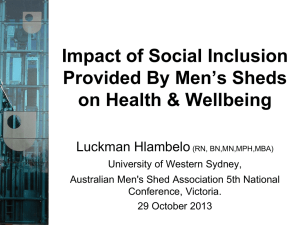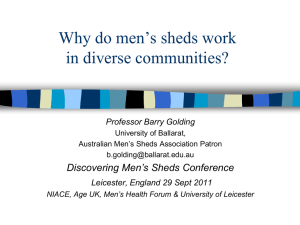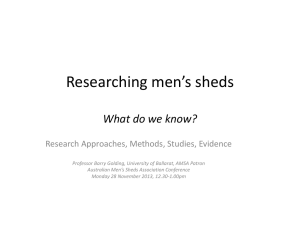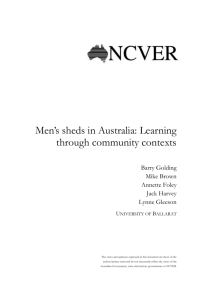Researching older men`s self-directed learning in
advertisement
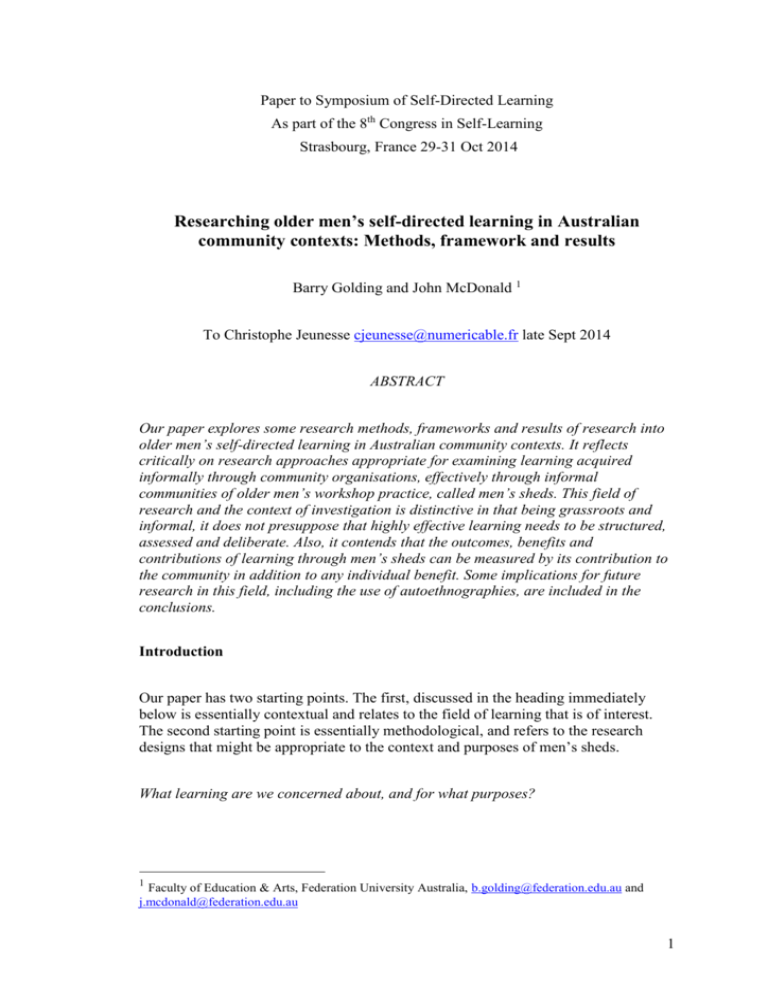
Paper to Symposium of Self-Directed Learning As part of the 8th Congress in Self-Learning Strasbourg, France 29-31 Oct 2014 Researching older men’s self-directed learning in Australian community contexts: Methods, framework and results Barry Golding and John McDonald 1 To Christophe Jeunesse cjeunesse@numericable.fr late Sept 2014 ABSTRACT Our paper explores some research methods, frameworks and results of research into older men’s self-directed learning in Australian community contexts. It reflects critically on research approaches appropriate for examining learning acquired informally through community organisations, effectively through informal communities of older men’s workshop practice, called men’s sheds. This field of research and the context of investigation is distinctive in that being grassroots and informal, it does not presuppose that highly effective learning needs to be structured, assessed and deliberate. Also, it contends that the outcomes, benefits and contributions of learning through men’s sheds can be measured by its contribution to the community in addition to any individual benefit. Some implications for future research in this field, including the use of autoethnographies, are included in the conclusions. Introduction Our paper has two starting points. The first, discussed in the heading immediately below is essentially contextual and relates to the field of learning that is of interest. The second starting point is essentially methodological, and refers to the research designs that might be appropriate to the context and purposes of men’s sheds. What learning are we concerned about, and for what purposes? 1 Faculty of Education & Arts, Federation University Australia, b.golding@federation.edu.au and j.mcdonald@federation.edu.au 1 Researching older men’s self-directed learning in community contexts is our particular research interest in this paper. This field of study neatly fits Foucault’s (1980) category of ‘subjugated knowledge’, in that it might be regarded in some educational hierarchies as local, regional, vernacular and naïve. Field (2000, p. 35) described a relatively recent fundamental shift in the learning behaviour of adults, who increasingly regard the day-to-day practice of less formal adult learning as routine. Mark (2013, p. 778) describes the shift from more formal adult learning for the very few, to a newer, less formal lifelong learning for many more adults of all ages in Scotland: The new adult learning is part of a much broader process. As individuals come to rely less on traditional institutions and the authority figures associated with them – church leaders, parents, aristocracy – to guide their behaviour, so they become more selfdirected. Much literature, research and policy on education for adults available to Anglophone speakers is written in English and from Western liberal democracies. From a neoliberalist standpoint, the acquisition of formal educational skills and qualifications is primarily for individual economic advancement and employment prospects. However, we regard this as an obsolete notion insofar as it applies to adult learning. Our interest in this paper is in the broader value of older men’s informal and lifelong learning, including learning that is lifewide: that is, for other purposes and across the life course at any age. Using Pollard’s (2010, p. 362) three-strand typology of learning, our interest goes mainly to the second and third strands of philosophical and political thinking on educational purposes to be found in contemporary Western democracies: these are essentially concerned with social cohesion and inclusion, in addition to wellbeing. Our particular concern is that the first strand, which regards teaching and learning as being linked mainly or solely to economic productivity, gets most of the attention. While seductive in policy terms, our argument is that this is a partial and impoverished view of the wider benefits of learning. While we acknowledge, with Pollard (2010), that the three strands are ‘deeply interconnected’ (p. 362), and accept that there is a demonstrated correlation between school and post-school educational success and employment, like Gorard (2010) we are more concerned about the persistent flipside for some older men. That is, that lack of success in learning is typically correlated with increasing difficulties through life, in and beyond paid work, and that many of these difficulties are closely related to class and family background. Further, our concern is that many of these disadvantages go well beyond the individual to become intergenerational and familial, and are exacerbated and reproduced by formal educational learning. Our concern in this paper is to avoid simplistically linking educational qualifications with employment for older men, without acknowledging the inequity of prior education as the central determinant for selection to employment. As Gorard (2010) puts it, when we take a life course view, qualifications, rather than being a causative agent, can alternatively be seen as ‘a substitute variable summing up the prior individual, economic social and economic determinants of ‘success’ at school and beyond’ (p. 359). As Gorard concludes: 2 Educators do not select their potential students, nor employers their employees, on the basis of their socio-economic status, ethnicity or age, as this is both unfair and illegal. However, they do select them on the basis of a substitute variable – prior education – that sums up, and is very heavily correlated with, such background factors. What is the sense in that? (Gorard, 2010, p. 358) Much educational discourse is premised on the idea that access can be broadened if young people and adults can be encouraged to become ‘aspirational’, that is to overcome impediments or ‘barriers’ to the desirable education on ‘the other side’. Gorard’s (2010) scathing critique of ‘barriers to learning’ is a good starting point in a critical examination of older men’s learning. Gorard uses UK data to show that once family background, sex and age are accounted for, ‘none of the measurable variables in adult life makes any difference to the quality of the predictions’ (p. 357) about adult participation in learning. Gorard concludes that ‘We need to revise our complacency that the existing set-up for learning is appropriate for all, and that the reluctant learner need only be lured back ‘on track’ (p. 357). Indeed, most adult nonparticipants in formal learning are not put off by barriers, ‘but by their lack of interest in something that seems alien and imposed by others’ (Gorard, 2010, p. 357). A useful way of perceiving learning barriers, is to acknowledge that there are at least three factors, beyond the contextual, institutional, informational, situational and personal/dispositional factors, that come into play for many older men. The first is the accumulation of often negative early school experiences and their subsequent association with other forms of learning later in life. The second is the stigma that some older men experience associated with literacy and learning difficulties in more formal educational contexts. The third is the male culture of ridicule about pursuing learning, which some male peers regard as inappropriate and not masculine. What some men can and do experience in some educational contexts is neatly summarised from Owens’ (2000) research from Ireland in TSA (2009, p. 21) as: … a deeply internalised sense of powerlessness … rooted in early school experiences and in the wider cultural milieu wherein the dominant ideologies of the social order and masculinity dictate one’s way of perceiving and being in the world. Research designs that match the context and purpose of learning Our second starting point is to go ‘back to the basics’ of research design. Qualitative research designs are typically shaped by the interplay of at least five key elements: the purposes and or outcomes of the research, the theory or conceptual framework that informs it, the constraints (typically political, ethical, pragmatic or resources), the choice of methods of data collection and analysis, and also ‘the philosophical or ontological perspective of the researcher’ (Sunderland, 2013, p. 59). Consistent with both the first and final design elements above, we value research designs that respect the research participants. Griffiths (2014) might suggest we are in a relatively privileged position, as academics rather than shedders, to ‘give voice’ to the participants of men’ sheds, who unlike us, ‘may not otherwise have access to 3 public spaces in which they can make their perspectives known’. Griffiths (2014) stresses that as researchers, whichever methods we use, whether we acknowledge it or not, we are always already in our texts, in the judgments and choices we make, about methodologies and foci of interest, including in this paper. This leads us to a closely related observation about research and its accessibility to participants. Whatever the narrow and specific academic purposes of research, our fundamental argument is that any research undertaken in grassroots places and spaces (including community men’s sheds) should make a wider and deeper contribution. In the case of community men’s sheds, research should help inform shedders and the shed-based organisations which run or auspice them. We contend that any research should be accessible, in at least some formats, to participants, as a form of reciprocity for time and effort involved in their participation as research subjects. Our specific interest in men’s sheds So what might be some appropriate research designs for investigating the less formal learning, exemplified by older men involved as participants in community men’s sheds? Men’s sheds and their relationship to learning for older men are comprehensively discussed in Golding (2014). Golding used the ‘grassroots’ shed movement to challenge preconceptions about the difficulty of enabling older men’s agency and learning. Golding (2014, pp. 125-6) regards men’s sheds in community settings as being simultaneously conservative and radical. On the one hand, sheds are conservative in that they reinforce and celebrate some traditional ways of being a man and doing things ‘shoulder to shoulder’. On the other hand they are radical in that they are based on models of community involvement that are democratic and inclusive, which eschew negative and hegemonic masculinities about women, promote salutogenic (health promoting) behaviour and encourage learner autonomy. Our interest includes informal learning that extends into health, wellbeing and community development. Our interest in exploring these three themes in greater depth in this part of the paper were provoked in part by Wilson and Cordier’s recent (2013) narrative review of the men’s shed literature. While we regard the review as useful and timely, and agree that ‘The range of variables that might contribute towards best practice in Men’s Sheds has not yet been adequately conceptualised, measured, tested or understood’ (2013, p. 458), we have two main points of departure. The first concerns Wilson and Cordier’s (2013) contention that the positivist paradigm is the ‘gold standard’ for evaluating research in this field. The second is their suggestion that the potential health benefits of men’s sheds should be the sole or principal concern. Wilson and Cordier (2013) are particularly critical of mixed method studies in the men’s shed field, arguing that qualitative approaches lack scientific rigour and generalizability of findings. However, because men’s sheds are community-based and very diverse in terms of their location, context, organisation, purposes, participants 4 and outcomes across four nations, ‘gold standard’ research designs to measure men’s health outcomes are unlikely to produce generalizable findings. The expansion of the grassroots men’s shed movement can be understood precisely because each shed emerges and takes shape in response to local community needs. No two sheds are the same. Sheds defy engineering by centralist bureaucracies. Therefore, imposing a positivist research paradigm to define universal ‘best practice’ seems futile, as does subjecting sheds to an evaluative regime designed to measure shedders’ health outcomes. Defining some appropriate research questions about men’s sheds Before examining what appropriate research questions might more effectively investigate men’ sheds and their link to learning, it is important to briefly define what they are. Golding (2014, p. 119) defines a men’s shed in a community setting (as distinct from a personal backyard shed) as providing: … a safe, regular social space for informal voluntary activity and programmes with very diverse possibilities and outcomes matching the men and communities in which they are embedded. Unlike personal sheds, they are available to groups of men, organised independently or with auspice arrangements through a wide variety of other community organisations. …. The activity usually (but not always) takes place in a group workshop type space with tools and equipment in a public, shed-type setting. The community men’s shed movement, founded in Australia, has grown in just two decades from early, isolated experimentation in a small number of sheds and communities in mainly rural South Australia, to a fully-blown, strongly networked, international movement, with more than 1,000 men’s sheds open worldwide, coordinated by four national associations in Australia, Ireland, the UK and New Zealand. It is thus timely to critically examine four key questions: ‘How and why has this happened? What does this mean for the men involved? What does it mean for the community?’ and ‘What does it mean for new models of service ‘provision’ (of adult education, aged care and health, for example)?’ Many nations, governments, communities and service providers are struggling to address some of the pressing issues faced by an increasing proportion of older or un(der)employed men disconnected from their communities and dislocated from the labour force. They are also interested in how grassroots movements, for and by men themselves, were actually created and took hold. Being essentially a decentred, ‘ground up’ movement, this latter narrative of how and why community men’s sheds emerged is best approached by historical analysis, exposing many fascinating and diverse early strands and agendas in each of the four nations, only one of which is about men’s health. This first question, how and why this has happened, is being covered more comprehensively in a book by Golding (in preparation, 2014) about The men’s shed movement. The second question – about what it means for participants – seems to be particularly amenable to interpretivist, qualitative research methodologies. By focusing on 5 understanding the meaning and lived experiences of the participants (Denzin & Lincoln, 2000), research is situated in the community being studied, and relies on emergent rather than predetermined research designs. The general characteristics of qualitative research, summarised by Marshall and Rossman (2011) appear to be particularly relevant in a men’s shed setting, given that the research is taking place in the natural setting (as distinct from a controlled environment), using multiple methods of inquiry and data collection that are interactive and humanistic, and taking particular account of the context in which the inquiry is conducted. The key point is the link between the context and purpose of the research, and a qualitative or mixed method approach. Creswell (2012) argues that it is appropriate to use qualitative research when our purpose is primarily exploratory such as when variables are difficult to isolate or measure, when we want to hear stories of the marginalised, when we want an in-depth, complex understanding of a phenomenon, when we want to empower individuals, and when the context or setting is important for understanding. All of these are apposite to men’s shed research. The third question of what men’s sheds mean for the wider community is one that has not been comprehensively researched. Most studies of community men’s sheds take it as given that men are the sole participants and beneficiaries. However in the case of community men’s sheds, none of the conventional top-down constructs – of student, customer, client or patient – sit comfortably with men who participate, since they come from service models presupposing deficit rather than agency. Further, participants and beneficiaries in many men’s sheds also include volunteers, women and young people. Anecdotal evidence suggests that beneficiaries beyond the shed often include partners and families, children and grandchildren, other community organisations and government agencies. The informal learning for any of these other potential beneficiaries is likely to be extensive but has rarely been systematically examined. The answer to the final question about what men’s sheds mean for new models of service ‘provision’ is particularly interesting and challenging, for gender-related reasons neatly summarised by the findings of a review of services for older men by Ruxton (2006) in the UK. There has been a trend until very recently to provide services through organisations in the community which have: either gender blind policies and practices, where men and women are treated the same; are gender differentiated, particularly towards women (where women are treated differently and separately); or agnostic, where there is no identifiable approach, particularly towards acknowledging that some men might be disadvantaged. Ruxton concluded that while the first two strategies, of gender blindness and gender differentiation ‘… were more effective, having a strategy was more important than what the strategy was’ (original bolding). Rather than being prescriptive, Ruxton recommended that providers of services to older people ‘develop a strategic approach to working with older men that is appropriate to their individual circumstances and the needs of their communities.’ Consistent with this finding, Men’s Sheds associations in each country have adopted a liberal policy framework. Associations are not prescriptive of its member organisation 6 about how sheds should be organised, in what way women might be involved, what should happen in a shed (other than it being safe and salutogenic: health promoting) or who should participate, aside from acknowledging that the main participants are typically men, and that all men should be made welcome. Though most men’s sheds take a male-focused, gender-differentiated approach (Ruxton, 2006), many sheds actively involve and include women as participants. Some sheds in both conservative and progressive communities have sometimes drawn back from naming the organisation or the place where the hands-on activity occurs as a men’s space and call it a community shed. The answers to the third and fourth questions, above, illustrate why a positivist research paradigm in men’s sheds is always going to involve compromises and tradeoffs. A good example in recent research is the valiant attempt by Flood and Blair (2013) to test the relationship between participation in men’s sheds in Australia and physical health and wellbeing. The study used a quasi-experimental design that included a non-shed control group carefully matched with a shed participant sample, ‘… in order to ascertain whether there are associative factors related to differences between the groups’ (p. 6). It aimed specifically to test ‘the hypothesis that those belonging to a Men’s Shed will have better health outcomes and behaviours than the control group’, in order to ‘rigorously [test] the relationship between Sheds and health’ (p.6). It therefore used identical, paper-based and online questions about selfperceived health and wellbeing administered to both groups of men. The obvious and insoluble problem here is that men who participate in men’s sheds may (or may not) be comparable to other men. Some men who do participate may be more active and enjoy better self-perceived health than men who do not participate. Conversely, it could be argued that because of professional referral or self-selection to a men’s shed (for reasons of unemployment, social isolation, or poor health), men’s sheds participants will be less healthy anyway. Compounding these difficulties, and inevitable in any longitudinal study, is the fact that the longer that older men participate in a men’s shed (median age 70 years in the Flood and Blair [2013] study), the less likely they are to be well (or employed, or learning) simply because of the cumulative effects of ageing. In an effort to establish significant difference between shed and non-shed groups, Floor and Blair (2013, p. 16) assumed that the shed participant group can and should be compared to a ‘less socially active’ non-shedders group. This was justified on the grounds that: … a more legitimate group for comparison for health factors are those who match the Shed members demographically but are not engaged in Sheds or meaningful activities. (p. 16) While this produced some small but ‘statistically significant differences’ on (SF-12)2 health scores and (WEMWBS)3 mental wellbeing scores, without other data, it raises 2 3 A standardized, international health survey-scoring instrument. An international mental wellbeing scale. 7 other important and unanswered questions, including what a significant difference might actually mean. What are the purposes and intended outcomes of men’s shed research? It is useful at this point to look closely at the purposes and outcomes of two qualitative case studies of community men’s sheds. One, conducted by Ballinger (2007). Another was by Sunderland (2013) on the Taieri Bloke’s Shed in Dunedin, New Zealand. Ballinger’s stated intention in an unidentified shed was quite specific: to explore whether and how the men’s shed was health promoting. By contrast, Sunderland (p. 64) clearly stated that ‘There is no problem being addressed in this research, but I have set clear aims for the study’, specifically determining ‘how the culture’ of the men’s sheds works ‘as viewed through an occupational lens’. While Ballinger relied on semi-structured interviews with staff and participants as well as document analysis, Sunderland used ethnography by immersing himself in the shed activities. Sunderland’s stated ‘ultimate purpose’ (p. 20) was ‘to investigate the worth of this particular community and provide recommendations that have application to the wider Men’s Shed movement.’ Relevant here is not only the very different methods chosen for quite different purposes and aims, but also the very different nature of the sheds chosen for their case studies. While Ballinger (p. 29) regarded her unnamed men’s shed as being ‘fairly typical of other men’s sheds’, she made it clear that the men’s shed chosen for the case study operated under the auspices of a community health service. By contrast Sunderland’s ethnographic case study (within the discipline of occupational science) was located in a men’s shed that was unaligned with any health-focused organisation, including with the New Zealand shed movement. Sunderland concluded that while the shed was ‘first and foremost a place of production, constructive work is the key occupation and the reason why men join and are involved’ (p. 192). Amongst Sunderland’s important conclusions is the powerful finding that it was the ‘… making of the place itself [that] has been important in the development of relationships and effectiveness of the Taieri Blokes Shed’ (Sunderland 2013, p. 202, italics added). Letting the men speak We return finally to a theme that we (Foley, Golding & Brown, 2008) began to tease out in 2008, arguing that one of the most effective ways of reporting on what happens in a men’s shed is to let the men speak, with minimal researcher intervention. Muncey (2010) identifies the particular power of autoethnographies to represent the chaotic and messy nature of human experience, and argues for a pluralism of discursive and interpretive methods. We offer two examples (Creswick, 2007; Dubbo, 2012) of collected wisdom and life experiences from men who participate in men’s sheds, proudly published by the sheds and shedders themselves, and in their own words, that provide an extremely rich resource for researchers. Unburdened by external research ethics, the men chose to be included, to tell all, and to be personally identified along with their sheds. 8 We will focus, for brevity, on a few brief but powerful extracts from the Dubbo Community Men’s Shed collection, a booklet of 128 pages, with deep and detailed life stories of twelve shedders. The cover notes introduce the context. What do an Aboriginal poet, retired copper4, truckie, one-time communist, ex-con, farmer, country ambo and a former prisoner-of-war have in common? … Told in their own words, and in a spirit of reconciliation, these personal journeys are raw, honest, courageous and often funny, proving the old adage that in every life there is a good story to tell. The Aboriginal elder and poet, ‘Riverbank’, Frank Doolan, accurately observes on the cover that ‘“Hey brother, tell me a story”, might just be the most life changing thing you can say to a person’. In his own narrative, Frank tells, in an understated way about how the young ‘local fellas’ in Dubbo have tried to push the caravan (that is his home on the riverbank) into the river, smashing all the windows, acutely observing that “It takes a big tough bloke to do that, I guess” In the next breath, Frank generously advocates for Aboriginal reconciliation, having designed the Dubbo men’s shed’s logo of a black and white handshake under a shed roof. The depth and power of these narratives can never be reduced to a statistical correlation between independent and dependent variables. Discussion and Conclusion Because there are many different sheds for many purposes and researcher interests, one method ‘does not fit all’. We conclude that amongst the wide range of available research methodologies, one of the most insightful and powerful is the raw and only minimally mediated, published stories (narratives) of men who participate. The Creswick and Dubbo Men’s Shed narrative collections not only illustrate a wide range of very powerful ideas and themes. They also confirm that a researcher need not necessarily play any role, other than as reader and interpreter of multiple themes. As Frank Doolan (Dubbo, 2012) said: A lot of these guys [in the Men’s Shed] especially the older ones, built the town we live in now, they put in the hard work and nobody thought to ask them about it. In Aboriginal culture every story is valid – it’s something the broader community can learn from. (p. 15) … It’s just a shame that here in Australia a man can get to a certain age and never get a chance to say to someone, this is what I did. Sometimes the best you can do for a bloke is say, pull up a chair brother and tell me where you’ve been (p. 17). We conclude that it is precisely because of the power of storying and reflecting on it, that there is room for the existence of gendered, masculine, community spaces for men, which include, but go well beyond, instrumental concerns about physical and mental health. Men’s sheds provide an informal environment where men can let down their (hegemonic and hetero-normative) guard, feel safe to expose some of the ‘copper’ = policeman; ‘truckie’ = truck driver; ‘con’ = convicted criminal; ‘ambo’ = ambulance driver. 4 9 fragilities and vulnerabilities of their past and present without feeling judged as a weak or ‘lesser’ male, and to gather resources to develop capabilities for individual agency (Foley, 2014). What men share and learn from each other in a social, local and situated context (Golding, Mark & Foley, 2014) is precisely why community men’s sheds work and why qualitative methodologies are particularly relevant to this field. References Ballinger, M. (2007) More than a place to do woodwork: A case study of a community-based Men’s Shed, Master of Health Sciences Thesis. Bundoora: La Trobe University. Creswell, J. (2012) Qualitative inquiry and research design: Choosing among five approaches. 3rd ed. Thousand Oaks: Sage. Creswick (2007) Tales from the Shed: Collected wit, wisdom and tales from the Creswick Men’s Friendship Shed in 2007. Creswick: Creswick Men’s Friendship Shed. Denzin, N. & Lincoln, Y. (2000) Handbook of qualitative research (2nd ed.). Thousand Oaks: Sage. Dubbo (2012) A shed load of stories: From the Dubbo Community Men’s Shed. Dubbo: Western Xpress Printing. Field, J. (2000) Lifelong learning and the new educational order. Stoke on Trent: Trentham Books. Flood, P. & Blair, S. (2013) Men’s sheds in Australia: Effects on physical health and mental well-being, Report for beyondblue. Melbourne: Ultrafeedback. Foley, A. (2014) A case for some men’ spaces, in B. Golding, R. Mark & A Foley (eds.) Men learning through life. Leicester: NIACE, pp. 63-76. Foley, A., Golding B. & Brown, M. (2008) Let the men speak: Health, friendship, community and shed therapy, Paper to AVETRA Conference, Adelaide, 3-4 April. Foucault, M. (1980) Power/knowledge: Selected interviews and other writings 197277. New York: Pantheon. Golding, B. (2014) Men’s sheds: A new movement for change, in B. Golding, R. Mark & A Foley (eds.) Men learning through life. Leicester: NIACE, pp. 11328. Golding, B. (2014, in preparation) The Men’s Shed movement. Golding, B., Mark, R. & Foley, A. (eds.) (2014) Men learning through life. Leicester: NIACE. Gorard, S. (2010) Participation in learning: Barriers to learning, in C. Cooper, J. Field, U. Goswami, R. Jenkins & B. Sahakian, Mental capital and wellbeing. Chichester: Wiley-Blackwell, pp. 351-60. Griffiths, M. (2014) Social justice: the central concern of critical research, Accessed 25 Sept from 10 http://www.strath.ac.uk/aer/materials/1educationalresearchandenquiry/unit4/soc ialjusticethecentralconcernofcriticalresearch/ Marshall, C. & Rossman, G. (2011) Designing qualitative research (5th ed.) Los Angeles: Sage. Muncey, T. ((2010) Creating autoethnographies. Los Angeles: Sage. Mark, R, (2013) From adult learning to lifelong learning in Scotland: Scottish Education 84: pp. 774-83. Owens. T. (2000) Men on the move. Dublin: AONTAS National Association of Adult Education. Pollard, A. (2010) Evidence-informed principles from the teaching and learning research programme, in C. Cooper, J. Field, U. Goswami, R. Jenkins & B. Sahakian, Mental capital and wellbeing. Chichester: Wiley-Blackwell, pp. 36167. Ruxton, S. (2006) Working with older men: A review of Age Concern services. London: Age Concern. TSA (2009) TSA Consultancy, Men and literacy: A study of attitude and experiences of learning, Dublin: NALA. Sunderland, J. (2013) The Taieri Blokes Shed: An ethnographic study, Master of Occupational Science Thesis. Dunedin: Dunedin Polytechnic. Wilson, N. & Cordier, R. (2013) A narrative review of Men’s Shed literature: Reducing social isolation and promoting men’s health and wellbeing. Health and Social Care in the Community 21: 5, pp. 451-63. 11
